About one in 13 people have flexible ape-like feet, US scientists have discovered.
A team studied the feet of 398 visitors to the Boston Museum of Science.
The results show differences in foot bone structure similar to those seen in fossils of a member of the human lineage from two million years ago.
It is hoped the research, published in the American Journal of Physical Anthropology, will establish how that creature moved.
Apes like the chimpanzee spend a lot of their time in trees, so their flexible feet are essential to grip branches and allow them to move around quickly – but how most of us ended up with more rigid feet remains unclear.
Jeremy DeSilva from Boston University and a colleague asked the museum visitors to walk barefoot and observed how they walked by using a mechanized carpet that was able to analyze several components of the foot.

About one in 13 people have flexible ape-like feet
Most of us have very rigid feet, helpful for stability, with stiff ligaments holding the bones in the foot together.
When primates lift their heels off the ground, however, they have a floppy foot with nothing holding their bones together.
This is known as a midtarsal break and is similar to what the Boston team identified in some of their participants.
This makes the middle part of the foot bend more easily as the subject pushes off to propel themselves on to their next step.
Prof. Jeremy DeSilva said how we might be able to observe whether we have this flexibility: “The best way to see this is if you’re walking on the beach and leaving footprints, the middle portion of your footprint would have a big ridge that might show your foot is actually folding in that area.”
Another way, he added, was to set up a video camera and record yourself walking, to observe the bones responsible for this folding motion.
Most with this flexibility did not realize they had it and there was no observable difference in the speed of their stride.
In addition, Prof. Jeremy DeSilva found that people with a flexible fold in their feet also roll to the inside of their foot as they walk.
The bone structure of a two-million-year old fossil human relative, Australopithecus sediba, suggests it also had this mobility.
“We are using variation in humans today as a model for understanding what this human creature two million years ago was doing,” added Prof. Jeremy De Silva.
After Europe hailed his discovery of the Americas in the 15th century, Christopher Columbus was blamed for introducing syphilis to Old World.
However, several reports have since argued the case that the deadly disease was already widespread before Columbus landed back in Spain in 1493.
Researchers George Armelagos, from Emory University, Molly Zuckerman, from Mississippi State University and Columbia University’s Kristin Harper, claim that all the evidence putting Christopher Columbus and his crew in the clear is flawed.
George Armelagos told LiveScience: “There’s no really good evidence of a syphilis case before 1492 in Europe.”

After Europe hailed his discovery of the Americas in the 15th century, Christopher Columbus was blamed for introducing syphilis to Old World
Curable in the present day by antibiotics, syphilis used to be a debilitating and often fatal disease.
Caused by the Treponema pallidum bacteria, syphilis affected the heart, brain, eyes and bones and was the scourge of every major city.
Ever since the first recorded case in Europe took place in 1495 – three years after Christopher Columbus’s first voyage to the New World – doctors have argued over its origins.
Historians who argue that Christopher Columbus couldn’t have been source point out that rudimentary 15th century medical know-how meant that doctors would not have been able to distinguish the disease among others that had similar symptoms, so it could have been around for a long time.
There are also skeletons from Europe that pre-date Columbus’s epic voyage and that show signs of syphilitic lesions.
It’s strong evidence and George Armelagos admits to finding the idea of Christopher Columbus bringing the disease back laughable at first.
But then he began a closer inspection of the 54 published reports putting Columbus in the clear.
George Armelagos found that the skeletal material wasn’t irrefutable proof, by any means.
Writing in the American Journal of Physical Anthropology, George Armelagos’ team report: “We did not find a single case of Old World treponemal disease that has both a certain diagnosis and a secure pre-Columbian date.
“We also demonstrate that many of the reports use non-specific indicators to diagnose treponemal disease, do not provide adequate information about the methods used to date specimens, and do not include high-quality photographs of the lesions of interest.”
In the cases where the skeletons definitely were afflicted with syphilis, the researchers noted that they came from coastal areas, which would make radio-carbon dating difficult.
This is because it’s likely the victims ate seafood, which can contain carbon many thousands of years old from water wells.
The team adds: “Solid evidence supporting an Old World origin for the disease remains absent.”


